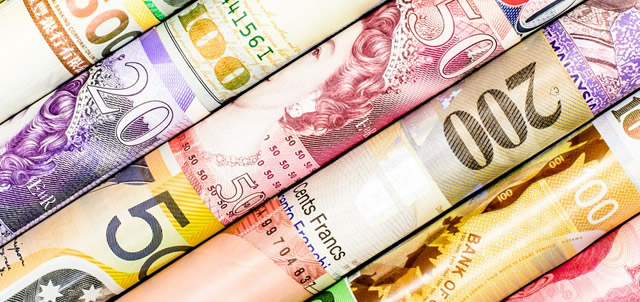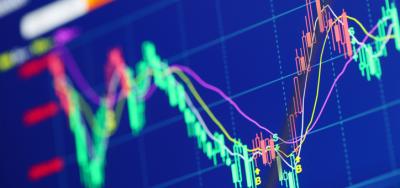Currency Risk: Why It Matters to You

Some investment professionals encourage using foreign stocks and bonds to diversify portfolios. Since overseas assets often don’t track their U.S. counterparts closely, a globally diversified portfolio might help reduce volatility. These investments can directly introduce currency risk, which you might invite as part of your diversification strategy. But currency risk could be present among your other investments as well.
Understanding Currency Risk
Currency risk refers to the potential for either better or worse financial performance due to the fluctuation of foreign exchange rates between your home currency and another where you have exposure. For example, say you hold a European stock denominated in euros that has risen 10 percent. But during this time, the euro has fallen 10 percent against the U.S. dollar. If you sold your position and converted your funds back to dollars, you’d break even.
When you buy a foreign security, you’re investing in the asset itself and in the currency in which it’s denominated. If you hold an investment denominated in a currency that outperforms the U.S. dollar, this can boost your returns, while an investment denominated in a currency that underperforms the dollar can lower your returns.
How Currency Risk Can Impact Your Investments
You might recognize your direct exposure to currency risk if you own stock in a foreign company, such as a Japanese or German automaker or a French pharmaceutical company on an overseas exchange. But you can also take on currency risk through investments in domestic companies that trade on U.S. exchanges. Some of the largest U.S. companies earn much of their revenue overseas. There are times when they might face a substantial impact to their reported earnings based on currency fluctuations when they convert their foreign sales to dollars.
Companies can use a hedging strategy in which they buy or sell other investments to help offset losses and manage currency risk. For example, to hedge against currency risk, a company might consider investing in forward contracts for currencies where it has exposure. Forward contracts are private agreements between parties to engage in a transaction in the future.
Smaller companies might have potentially greater exposure to currency risk as they might not have the same ability or flexibility as larger firms to hedge their currency risk effectively. Even U.S. companies primarily serving domestic markets can face currency risk if they have important suppliers or competitors overseas.
Owning a diversified mutual fund or exchange-traded fund (ETF) might not protect you from currency risk exposure since some of the fund’s investments might face currency risk. For investors who are interested in insulating their investments against the impact of foreign currency fluctuations, there are a number of global- or foreign-focused ETFs and mutual funds that do offer currency-hedged exposure.
Buying shares in foreign companies listed on U.S. exchanges that trade in dollars might protect you from the direct currency risk you face by holding investments priced in foreign currencies. But the companies themselves still include currency risk related to their operations outside the U.S. For example, if you buy shares in a foreign company listed in the U.S. and trading in dollars, you might avoid the direct currency risk you’d take on if you bought the shares on a local exchange. However, you’ll still face the currency risk the company has from doing business in its home country.
Comparing Currency “Regimes”
A currency regime determines how a country’s currency is valued compared to other currencies. The main decision is whether exchange rates are to be fixed or floating.
A floating rate allows the price of a currency to move based on market conditions. If many people from other countries want to buy one country's goods or invest in its assets, the demand for that country's currency is higher, which pushes a floating exchange rate up. While floating rates typically fluctuate based on supply and demand in the foreign exchange market, a country might intervene in the market by buying (or selling) large amounts of its own currency to push the rate higher (or lower). The U.S. dollar, the euro and the Japanese yen are examples of floating currencies.
A fixed rate currency regime—which ties the value of a currency to another asset or index—can take several forms. A country might peg its currency to the price of gold or a basket of commodities, or it could link directly to another currency. For example, the Hong Kong dollar is pegged to the U.S. dollar and sticks to a very tight band between 7.75 and 7.85 per U.S. dollar. Meanwhile, Vietnam connects the dong to the U.S. dollar via a managed float, which allows for a trading band above or below the daily value set by the State Bank of Vietnam. One form of a fixed rate is known as dollarization, where a country simply adopts a foreign currency as its own legal tender. Panama, where U.S. dollars are freely used in everyday purchases, is an example.
When there’s higher demand for a currency and its price increases, goods and services priced in that currency can suddenly seem more expensive relative to comparable goods and services elsewhere in the world. This can result in companies operating in this currency becoming less competitive. Conversely, when there’s extra selling pressure on a currency, its value falls, and so too does the value of all property and wealth denominated in that currency. That country could face inflation pressures, although its exporting companies can get a boost in sales as their products become cheaper to foreign buyers.
If currency traders believe a fixed rate currency is mispriced, they’ll often sell or buy that currency in large quantity. A country’s central bank might be forced to intervene to sustain the existing peg, but buying its own currency can drain foreign reserves, possibly enough to weaken the country’s financial health. If there’s enough of a run on a currency—where most investors want to sell that currency—the government might not have sufficient resources to support the exchange rate, potentially forcing it to unpeg and devalue its currency, which can lead to widespread market upheaval.
Managing Currency Risk
A certain amount of exposure to currency risk is inevitable in a world with global markets and supply chains. If a major U.S. trading partner were to undergo a substantial currency devaluation, the interconnected nature of markets makes it difficult to completely protect your investments from the fallout.
It's possible to hedge currency risk in your portfolio with, for example, currency ETFs and other exchange-traded products, futures or options. But these strategies might introduce other significant risks and are best reserved for sophisticated investors with quantifiable, direct currency risk (i.e., assets denominated in foreign currencies).
To minimize your currency exposure, you should understand the exposure in your existing and potential investments, especially if you’re considering buying overseas assets. And be particularly careful concerning countries with heavily managed currencies, which are more likely to face substantial revaluations that impact asset values.
Before investing, consider talking with an investment professional who has expertise in foreign exchange rates or overseas investments. Be sure to evaluate the potential impact of currency risk on your portfolio and possible actions you can take to manage it.



